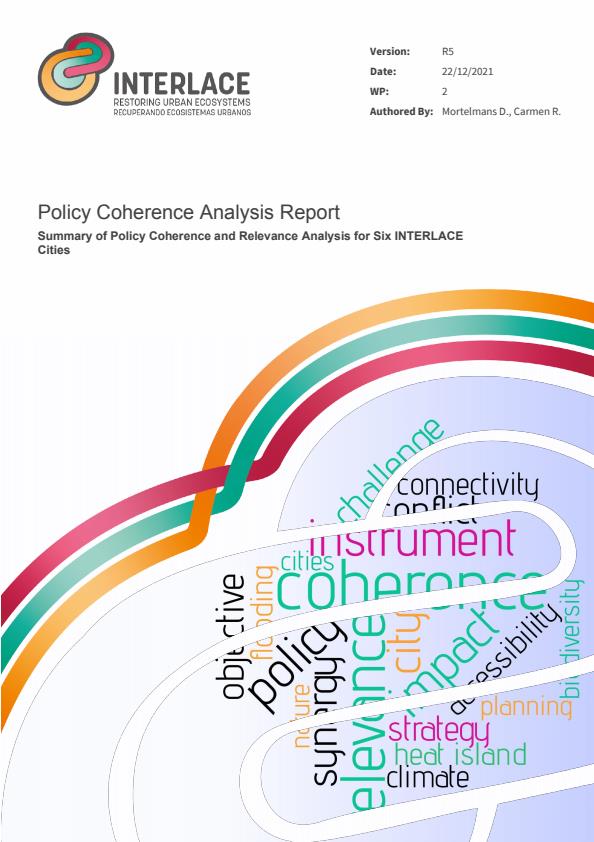Policy Coherence Analysis Report. Summary of Policy Coherence and Relevance Analysis for six INTERLACE Cities
This report summarizes an analysis of coherence and impact of policy instruments conducted in three European and three Latin-American cities or urban areas: Granollers (Spain), Chemnitz (Germany), Kraków (Poland), CBIMA (Costa Rica), Envigado (Colombia) and Portoviejo (Ecuador). The overall objective was to determine for each city, which policy instruments had the main impacts (negative or positive) on the city challenges and how well they operated together in achieving these challenges. In addition to this overall objective and based on expressed city needs, the respective policy coherence analyses focused on aspects of policy coherence that were relevant to their specific contexts (e.g., coherence of policy instruments under development in regard to implemented ones, exemplary synergies between policy instruments, etc.).
The policy coherence analysis was done using the PolCA method (Mortelmans et al, 2021) and is based on a series of policy coherence matrices that were filled in by policy experts from the respective city administrations. The PolCA method aims to capture local knowledge and expertise about policy instrument implementation and bring it together in a format apt to support discussions between decision makers with different sectoral backgrounds. At the same time, it aims to form a common reference for further discussions on policy instrument efficacy.
For each city, a list of key policy instruments and their impacts on the respective city challenges is provided, together with an overview of synergies and conflicts between these instruments. Knowledge gaps are systematically identified to allow, where needed, prioritization of further research needs on highly relevant impacts or synergies for the respective cities.
The results showed a few very strong synergetic policy instruments that could form potential inspiring examples of coherent policy mixes. There are also numerous policy instruments with neutral impacts on city challenges, suggesting that some city challenges are insufficiently addressed at this stage. Overall, it was remarkable that were few policy instruments with negative impacts or strongly conflicting with each other. The latter may result from the fact that respondents all belonged to city administrations. By expanding this analysis to a larger group of stakeholders, more contrasting results may yet appear.
Together with a governance assessment carried out in parallel to this coherence analysis (Deliverable 2.2), these reports aim to provide a better understanding of successful governance practices and effective policy instrument combinations to address the cities’ challenges and support the co-production of local governance solutions which will be carried out next in each of the INTERLACE cities.
Details
| Aantal pagina's | 76 |
|---|---|
| Type | Rapport niet door INBO uitgegeven |
| Categorie | Onderzoek |
| Taal | Engels |
Bibtex
@misc{8bc32d1e-2ed6-40af-8cc2-ccd52d484249,
title = "Policy Coherence Analysis Report",
abstract = "To get a better understanding to what extent a policy mix, or set of policy instruments, is effective in tackling key city challenges (e.g., the reduction of heat island effects, access to green areas or ecological connectivity), a policy coherence analysis is helpful. Policy coherence is essentially referring here to how effectively different policies and policy instruments work together regarding a range of challenges or objectives, particularly when they are the responsibility of different city departments.
This report summarizes an analysis of coherence and impact of policy instruments conducted in three European and three Latin-American cities or urban areas: Granollers (Spain), Chemnitz (Germany), Kraków (Poland), CBIMA (Costa Rica), Envigado (Colombia) and Portoviejo (Ecuador). The overall objective was to determine for each city, which policy instruments had the main impacts (negative or positive) on the city challenges and how well they operated together in achieving these challenges. In addition to this overall objective and based on expressed city needs, the respective policy coherence analyses focused on aspects of policy coherence that were relevant to their specific contexts (e.g., coherence of policy instruments under development in regard to implemented ones, exemplary synergies between policy instruments, etc.).
The policy coherence analysis was done using the PolCA method (Mortelmans et al, 2021) and is based on a series of policy coherence matrices that were filled in by policy experts from the respective city administrations. The PolCA method aims to capture local knowledge and expertise about policy instrument implementation and bring it together in a format apt to support discussions between decision makers with different sectoral backgrounds. At the same time, it aims to form a common reference for further discussions on policy instrument efficacy.
For each city, a list of key policy instruments and their impacts on the respective city challenges is provided, together with an overview of synergies and conflicts between these instruments. Knowledge gaps are systematically identified to allow, where needed, prioritization of further research needs on highly relevant impacts or synergies for the respective cities.
The results showed a few very strong synergetic policy instruments that could form potential inspiring examples of coherent policy mixes. There are also numerous policy instruments with neutral impacts on city challenges, suggesting that some city challenges are insufficiently addressed at this stage. Overall, it was remarkable that were few policy instruments with negative impacts or strongly conflicting with each other. The latter may result from the fact that respondents all belonged to city administrations. By expanding this analysis to a larger group of stakeholders, more contrasting results may yet appear.
Together with a governance assessment carried out in parallel to this coherence analysis (Deliverable 2.2), these reports aim to provide a better understanding of successful governance practices and effective policy instrument combinations to address the cities’ challenges and support the co-production of local governance solutions which will be carried out next in each of the INTERLACE cities.
",
author = "Dieter Mortelmans and Raïsa Carmen",
year = "2021",
month = dec,
day = "12",
doi = "",
language = "Nederlands",
publisher = "Instituut voor Natuur- en Bosonderzoek",
address = "België,
type = "Other"
}

